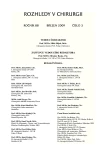Surgeon Josef Hohlbaum – Life Story
Authors:
J. Stingl 1; I. Kästner 2; A. Míšková 3; V. Musil 4,5
Authors‘ workplace:
Ústav anatomie 3. LF UK, Praha, přednosta: prof. MUDr. J. Stingl, CSc.
1; Karl-Sudhof-Institut für Geschichte der Medizin, Medizinische Fakultät, Universität Leipzig, Německo
přednosta: Prof. Dr. phil. Dr. med. O. Riha
2; Masarykův ústav a Archiv Akademie věd ČR, ředitel: doc. PhDr. I. Šedivý, CSc.
3; Středisko vědeckých informací 3. LF UK, vedoucí: PhDr. M. Hábová
4; Ústav informačních studií a knihovnictví, FF UK, Praha, ředitel: PhDr. R. Papík, Ph. D.
5
Published in:
Rozhl. Chir., 2009, roč. 88, č. 3, s. 151-157.
Category:
Monothematic special - Original
Overview
Professor Josef Hohlbaum (*Sept. 6, 1884 in Oberlindewiese, Northern Moravia) studied medicine in Graz, Austria. His main place of work was Leipzig, Germany, where he became an outstanding surgeon and a very good university teacher. Between 1941 and 1945, he was the last chairman of Surgery of the German University in Prague. On May 9, 1945, he was arrested by the Czech police and imprisoned in the internment camp in Klecany. At the end of June 1945, during farming work, his left leg was seriously injuried by an explosive, found by a Czech guard and thrown under Hohlbaums’ foot. J. Hohlbaum received first wound treatment and was admitted to the Surgical Department of the Královské Vinohrady Hospital in Prague 10, where he spent 6 weeks. Thereafter, at his request, he was transferred to the German Military Hospital in Prague 5. During the autumn of 1945, he was transferred to Germany, his condition grew more and more worse, and, consequently, his left lower extremity had to be amputated in femore. On December 30, 1945, he died of sepsis in the Surgical department of the Hospital in Markkleeberg, near Leipzig. The authors could not find any evidence that Hohlbaums’ professional contemporary, the Czech surgeon professor A. Jirásek, presented a non-ethical attitude to the injured J. Hohlbaum, and that Jirásek refused to treat him, as it has been repeatedly presented in German publications. On the contrary, it is evident from the documents found, that the care he got in Prague – with respect to the difficult circumstances – was lege artis. Hohlbaunťs life thus ended as a consequence of the situation at the end of WWII.
Key words:
surgeon Josef Hohlbaum – life story
Sources
1. Archiv Hlavního města Prahy, ITN, kartotéka Klecany.
2. Behrendt, K. P. Die Kriegschirurgie von 1939–1945 aus der Sicht der Beratender Chirurgen des deutschen Heeres im Zweiten Weltkrieg. Diss., Freiburg i. Br.: 2003, s. 243–245.
3. Čvančara, J. Heydrich. Praha: Gallery, 2004, s. 125–127.
4. Čvančara, J. Někomu život, někomu smrt. 1943–1945 Praha: Laguna, 2008, s. 166.
5. Hlaváčková, L. Prof. Arnold Jirásek a I. chirurgická klinika UK za druhé světové války. Práce z dějin Akademie věd, seria C, fasciculus 3: Věda v českých zemích za druhé světové války. Praha: Akademie věd ČR, 1998, s. 129–143.
6. Hübsch, J. Dopis A. Blumenwitzovi ze dne 24. 1. 1946. (Z archivu Dr. K. Hohlbauma).
7. Jirásek, A. Úvodní přednáška po otevření vysokých škol. Rozhl. Chir., 1945, roč. 24, s. 275–283.
8. Jirásek, A. Písemná pozůstalost. Archiv AV ČR.
9. Killian, H. Meister der Chirurgie und die Chirurgenschulen im gesamten Deutschen Sprachraum. 2. Aufl. Stuttgart: Thieme Verl., 1990, s. 62–63.
10. Klaus, K. Za války ve všeobecné nemocnici. Čas. lék. čes., 1945, roč. 84, s. 846–849.
11. Lang, H. Viel Glück auf dem Weg nach Munchen. Landsberg: Landsberger Verlagsanstalt, 1983, s. 75–105.
12. Niederle, B. Svár či smír? Rozhl. Chir., 1996, roč. 75, s. 276–277.
13. Niederle, B. Jiráskova klinika za Pražského květnového povstání. Čas. lék. čes., 1995, roč. 134, s. 281–283.
14. Novák, V. – osobní sdělení, březen 2006.
15. Novotná, E. – osobní sdělení, září 2008.
16. Pavrovská, V. – osobní sdělení, září 2006.
17. Pešek, M. Osudy I. české chirurgické kliniky v době okupace. In: 120 let 1. české chirurgické kliniky 1. lékařské fakulty Univerzity Karlovy v Praze. Praha: Nakladatelství Karolinum, 2002, s. 97–108.
18. Pirk, J., Matyášová, I. Srdce a srdíčka Jana Pirka. Praha: Nakladatelství Lidové noviny, 2007, s. 13–15.
19. Polák, E. Padesát let chirurgem (nepublikovaný strojopisný text v držení MUDr. Tománkové), s. 241.
20. Rommeney, R. Notářsky ověřený výpis z chorobopisu lazaretu v Ženských domovech v Praze. (Z archivu Dr. K. Hohlbauma).
21. Staněk, T. Tábory v českých zemích 1945–1948. Opava: Nakladatelství Tilia, 1996, s. 40–44.
22. Svobodný, P. Dieselben Leute – neue Karrieren. Die Schicksale von Hochschullehrern der Deutschen Medizinischen Fakultät in Prag nach 1945. In: M. Svatoš, L. Velek, A. Velková (Eds.). Praha: Magister Noster, 2005, s. 261–274.
Labels
Surgery Orthopaedics Trauma surgeryArticle was published in
Perspectives in Surgery

2009 Issue 3
- Metamizole vs. Tramadol in Postoperative Analgesia
- Metamizole at a Glance and in Practice – Effective Non-Opioid Analgesic for All Ages
- Possibilities of Using Metamizole in the Treatment of Acute Primary Headaches
Most read in this issue
- Position Variability of the Vermiform Appendix and Effect on Diagnosis of Appendicitis in Children
- Limitations of Liver Resections
- Bouveret‘s Syndrome – A Rare Case of Proximal Ileus of Biliary Etiology
- Giant Solitary Fibrous Tumor of the Pleura – Case Report
